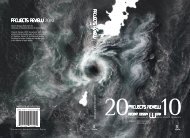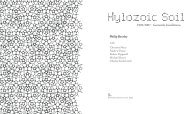The Inner Studio - Riverside Architectural Press
The Inner Studio - Riverside Architectural Press
The Inner Studio - Riverside Architectural Press
Create successful ePaper yourself
Turn your PDF publications into a flip-book with our unique Google optimized e-Paper software.
PART TWO | THE CREATIVE INSTINCT<br />
are carrying on an internal dialogue and answering our own questions<br />
through the creation of images, text, or drawings. What<br />
happens if I move that over here? Would it be better if the top of<br />
the building were shaped like this? Is that window really in the best<br />
place? I don’t like that. I like this. <strong>The</strong>re is a constant stream of<br />
inner commentary that accompanies our creations–a great deal of<br />
it silent and unconscious. What is important is that after a few<br />
years of studying design, we become increasingly aware that this is<br />
going on and learn how to participate in it consciously. <strong>The</strong> tone<br />
and immediacy of this voice becomes our companion in the<br />
creative world. By slowing down and reflecting on this process, I<br />
want to examine what happens when we become more aware of it.<br />
Can we actually use our awareness of this process to enhance our<br />
creative search?<br />
<strong>The</strong> inner world of design is activated by a call and response–a<br />
question asked and answered. I imagine it as the kind of interaction<br />
heard in religious services when the leader calls out a question<br />
and the congregation answers in unison. Following a designer’s<br />
question (call), the response is received in the form of an image or<br />
impulse from the unconscious. I think of this dynamic that occurs<br />
during the design process as the “designers’ liturgy.” It is at the<br />
center of the sacred studio and is the designer’s inner instrument<br />
of creation. <strong>The</strong> call is an ascending appeal and the response is a<br />
descent of that appeal into matter. Like inhaling and exhaling, the<br />
two are complementary and form a natural creative cycle. <strong>The</strong>y<br />
need each other to complete the cycle of design, a cycle of question<br />
and response that is naturally iterative and reflects the fact<br />
that an experiment is taking place. We never know the outcome<br />
when we start out on a creative task because the outcome, by definition,<br />
is unknown. As a byproduct of making the built world,<br />
designers learn to unconsciously explore the inner world of<br />
images, rituals, and unrecognized instincts that accompany and<br />
enable the transformation of spirit into matter.<br />
What is happening inside the designer’s mind during the<br />
process of design? When we set out to design something, we bring<br />
two worlds together. <strong>The</strong> world we are conscious of includes the<br />
conditions of the building site, the client’s needs, and the budget<br />
39





